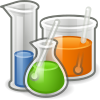 Global Information
Global InformationClick chemistry information
| Part of a series on |
| Chemistry |
|---|
 |
|
|
In chemical synthesis, click chemistry is a class of simple, atom-economy reactions commonly used for joining two molecular entities of choice. Click chemistry is not a single specific reaction, but describes a way of generating products that follow examples in nature, which also generates substances by joining small modular units. In many applications, click reactions join a biomolecule and a reporter molecule. Click chemistry is not limited to biological conditions: the concept of a "click" reaction has been used in chemoproteomic, pharmacological, biomimetic and molecular machinery applications.[1] However, they have been made notably useful in the detection, localization and qualification of biomolecules.
Click reactions occur in one pot, are not disturbed by water, generate minimal and inoffensive byproducts, and are "spring-loaded"—characterized by a high thermodynamic driving force that drives it quickly and irreversibly to high yield of a single reaction product, with high reaction specificity (in some cases, with both regio- and stereo-specificity). These qualities make click reactions particularly suitable to the problem of isolating and targeting molecules in complex biological environments. In such environments, products accordingly need to be physiologically stable and any byproducts need to be non-toxic (for in vivo systems).
By developing specific and controllable bioorthogonal reactions, scientists have opened up the possibility of hitting particular targets in complex cell lysates. Recently, scientists have adapted click chemistry for use in live cells, for example using small molecule probes that find and attach to their targets by click reactions. Despite challenges of cell permeability, bioorthogonality, background labeling, and reaction efficiency, click reactions have already proven useful in a new generation of pulldown experiments (in which particular targets can be isolated using, for instance, reporter molecules which bind to a certain column), and fluorescence spectrometry (in which the fluorophore is attached to a target of interest and the target quantified or located). More recently, novel methods have been used to incorporate click reaction partners onto and into biomolecules, including the incorporation of unnatural amino acids containing reactive groups into proteins and the modification of nucleotides. These techniques represent a part of the field of chemical biology, in which click chemistry plays a fundamental role by intentionally and specifically coupling modular units to various ends.
The term "click chemistry" was coined by K. Barry Sharpless' wife, Jan Dueser,[2] in 1998, and was first fully described by Sharpless, Hartmuth C. Kolb, and M.G. Finn of The Scripps Research Institute in 2001.[3][4] In 2022, the Nobel Prize in Chemistry was jointly awarded to Carolyn R. Bertozzi, Morten P. Meldal and K. Barry Sharpless, "for the development of click chemistry and bioorthogonal chemistry".[5]
- ^ Carroll, G.T.; London, G.; Fernandez-Landaluce, T.; Rudolf, P.; Feringa, B.L. (2011). "Adhesion of Photon-Driven Molecular Motors to Surfaces via 1,3-Dipolar Cycloadditions: Effect of Interfacial Interactions on Molecular Motion" (PDF). ACS Nano. 5 (1): 622–630. doi:10.1021/nn102876j. PMID 21207983. S2CID 39105918.
- ^ Nobel Prize lecture: Barry Sharpless, Nobel Prize in Chemistry 2022, retrieved 2024-01-04
- ^ H. C. Kolb; M. G. Finn; K. B. Sharpless (2001). "Click Chemistry: Diverse Chemical Function from a Few Good Reactions". Angewandte Chemie International Edition. 40 (11): 2004–2021. doi:10.1002/1521-3773(20010601)40:11<2004::AID-ANIE2004>3.0.CO;2-5. PMID 11433435.
- ^ R. A. Evans (2007). "The Rise of Azide–Alkyne 1,3-Dipolar 'Click' Cycloaddition and its Application to Polymer Science and Surface Modification". Australian Journal of Chemistry. 60 (6): 384–395. doi:10.1071/CH06457.
- ^ "The Nobel Prize in Chemistry 2022". NobelPrize.org. Retrieved 2022-10-05.